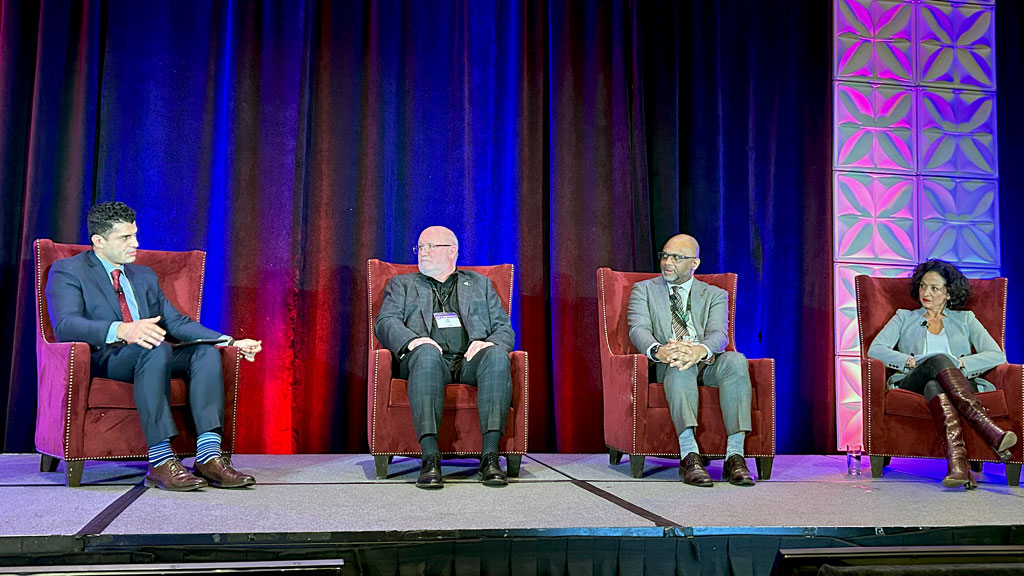Ontario’s Chief Prevention Officer Joel Moody said the Ministry of Labour is aware of the hazards associated with the roadbuilding sector and is always looking for ways to support the industry.
“One of the things we are always looking at is how do we better use data to help us understand what are the issues, the challenges that you’re facing.
“If you’re on the side of the roads, if you are interacting with other vehicles on the street, how does that interact with the safety of your workers?” said Moody during a panel discussion entitled Partners in Health and Safety: A Provincial Outlook at the Ontario Road Builders’ Association (ORBA) conference held recently in Toronto.
“We are always looking at finding ways in which we’re trying to create that buffer, trying to create that safety zone. For those businesses that are really going above and beyond, what’s simply required in the Occupational Health and Safety Act? How can we continue to support you?”
Health and safety isn’t ‘owned by the government’
Developing good habits is one way to support each other, said Moody.
“Health and safety is not owned by the government. It’s not owned by the WSIB. It’s shared amongst us all,” he said. “That’s why we talk about the shared responsibility system. It’s a balance between employer and employee but also the impact around government and its agencies.”
Jeffery Lang, president and CEO of the WSIB, said the economy is growing and expanding.
“As that expands so does our needs for labour and an increased attention to health and safety and prevention in the workplace,” said Lang. “As people enter the workforce, it’s paramount that they’re trained and that organizations, either the employers or associations like ORBA, don’t take their eye off the ball with regards to health and safety.”
It also makes sense financially for organizations, he pointed out, adding the WSIB sponsored research to drive ROI for spending on prevention which found that for every dollar companies invest in health and safety, they get $1.34 in return.
“Claims are what drive your costs, plain and simple,” he added. “Not only are we returning people to work quicker and safer, which helps you in a tight labour market, but we’re also keeping your premiums low.”
What you permit you promote
The first thing employers can do to promote a strong safety culture is for leaders to walk the talk in their personal life and at work, said Cristina Barlow of Mark’s Commercial.
“It seems silly, but show that safety is important to you in your personal life, not just a tick box exercise in your professional life,” she said. “I think there is this desire to chase a metric at the site level, which is X number of days without incidents. I think doing that is rewarding the outcome rather than the good behaviour. It’s the good behaviour that drives strong safety culture.”
That’s where the dual elements of reporting and accountability come into play, she added.
“If you have a 20-year veteran who is working at heights and is not wearing a harness because he’s only going to walk two or three steps and you allow that to happen, what you permit you promote,” she pointed out.
While the WSIB has had many successes over the past few years, including reducing premiums by 50 per cent since 2018 after getting rid of the unfunded liability, one of the biggest challenges, Lang says, are the outdated processes at the WSIB.
“Being 108 years old, we’ve got processes in place that 50 or 60 years ago made a lot of sense,” said Lang. “It’s like a highway and it’s accumulating with snow and we’ve got all these cars which are our people and they can’t get around because there is so much snow on the road. If you think of the snow as the processes at WSIB, my job is really to plow those roads and put salt on so we can get our traffic moving.”
They are also focusing on improving customer satisfaction.
“My goal for the WSIB over the next little bit is to deliver service better, easier and faster. By 2028 we are going to be remarkably simple to do business with,” he said.
Follow the author on Twitter @DCN_Angela.




Recent Comments
comments for this post are closed